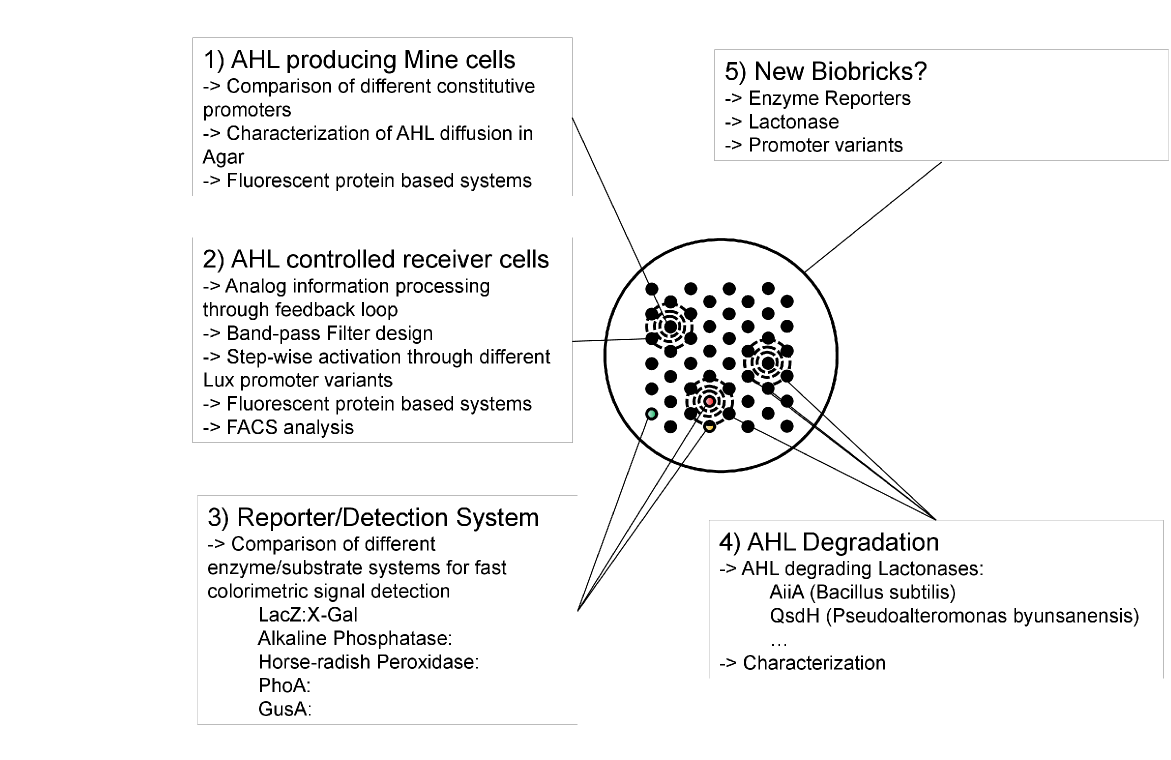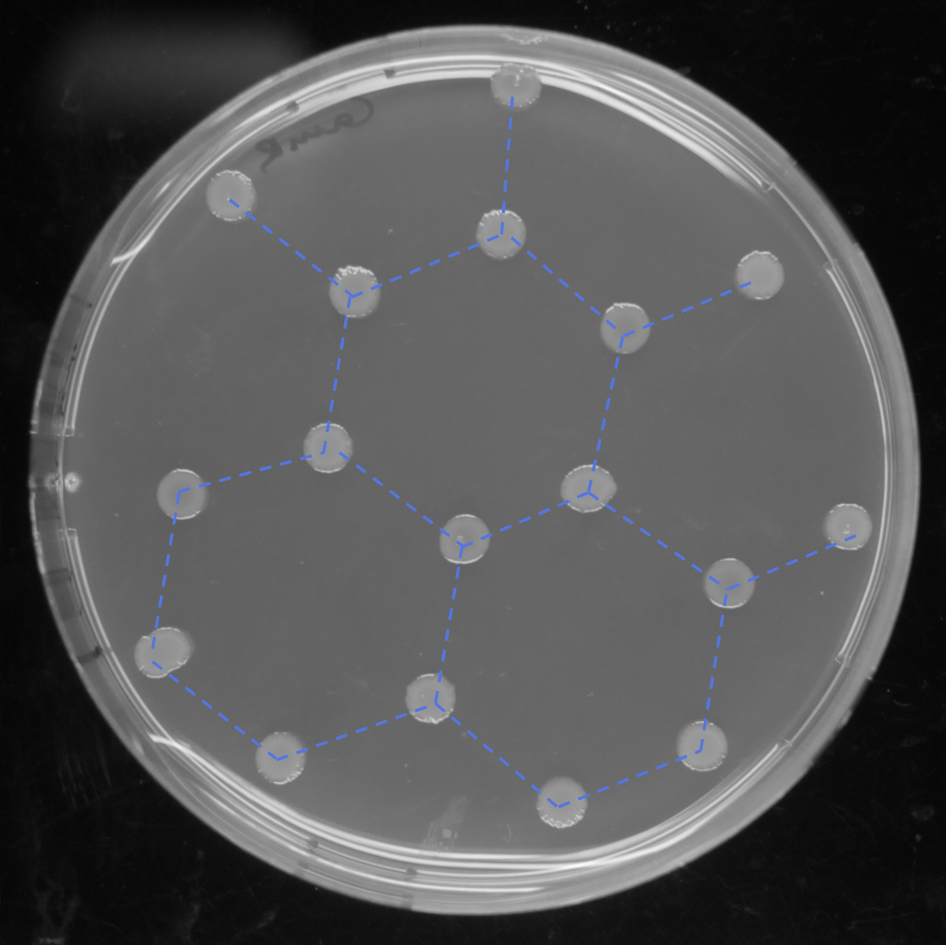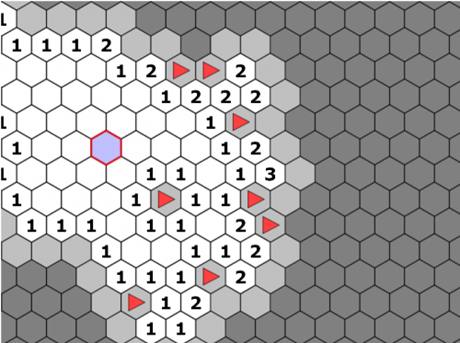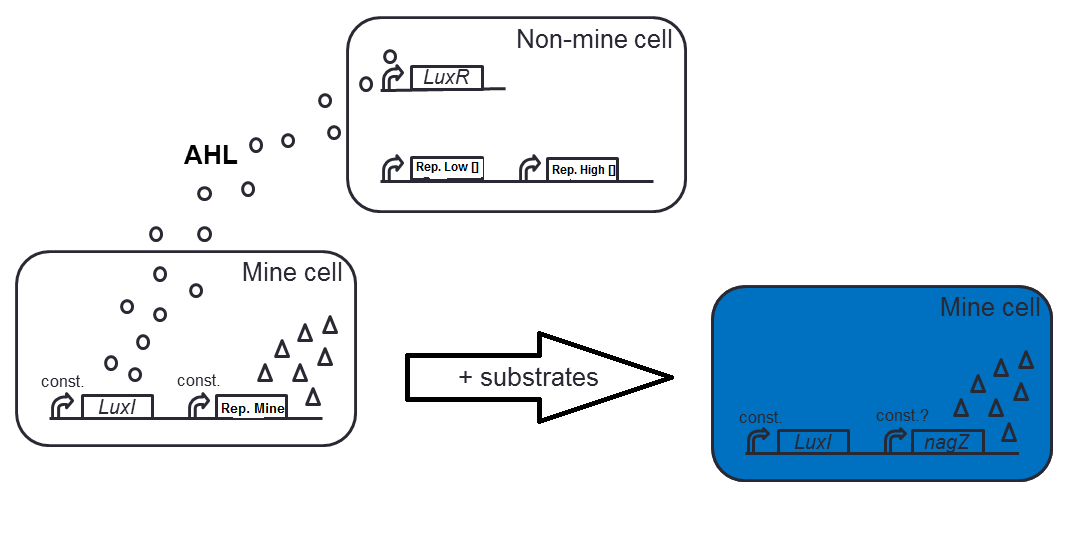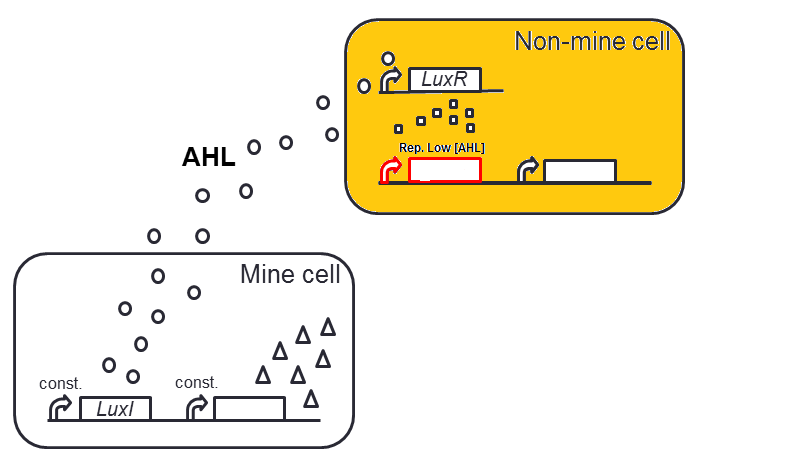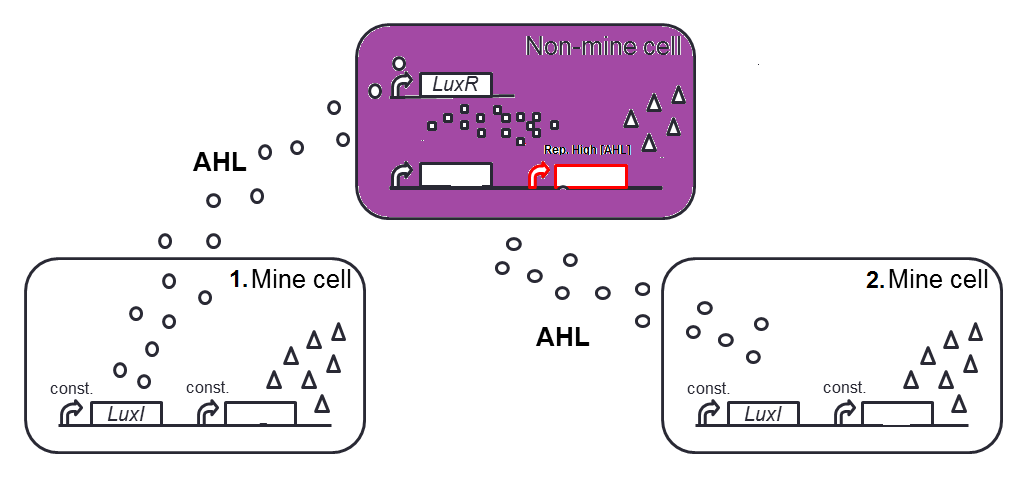Team:ETH Zurich/Project
From 2013.igem.org
(Difference between revisions)
| Line 35: | Line 35: | ||
<div id="Minesweeperdesign">[[Image:Minesweeperhexdesign.png|230px]]</div> | <div id="Minesweeperdesign">[[Image:Minesweeperhexdesign.png|230px]]</div> | ||
| - | <div style="position:absolute;top:810px;padding:10px;width:50%;height:auto;font-size:20px;font-family:Comic Sans MS;color:white">The simplest set up is to place E.coli colonies on an M9 agar plate in a certain pattern.<br><br> But how to choose the right pattern ?<br><br>The more intuitive way is to use the classic minesweeper pattern with squares, plating the colonies in the corner of the sqaures. The problem is we are working with the diffusion of <i>Acylated homoserine lactones (AHL)</i> therefore the colonies must be at the same distance. But in this pattern if we consider one colony X, 4 colonies will be at a distance 1, and 4 colonies will be at a distance √2.We would not be able to simulate correctly the indication of mines around.<br><br>Finally the hexagonal honeycomb like pattern seems to be perfectly adapted for our use because every intersection and centre of the hexagons are at the same distance to the | + | <div style="position:absolute;top:810px;padding:10px;width:50%;height:auto;font-size:20px;font-family:Comic Sans MS;color:white">The simplest set up is to place E.coli colonies on an M9 agar plate in a certain pattern.<br><br> But how to choose the right pattern ?<br><br>The more intuitive way is to use the classic minesweeper pattern with squares, plating the colonies in the corner of the sqaures. The problem is we are working with the diffusion of <i>Acylated homoserine lactones (AHL)</i> therefore the colonies must be at the same distance. But in this pattern if we consider one colony X, 4 colonies will be at a distance 1, and 4 colonies will be at a distance √2.We would not be able to simulate correctly the indication of mines around.<br><br>Finally the hexagonal honeycomb like pattern seems to be perfectly adapted for our use because every intersection and centre of the hexagons are at the same distance to the colonies around them.</div> |
Revision as of 09:31, 26 July 2013
Contents[hide] |
How to play minesweeper using E.Coli
As you certainly know a classic minesweeper has 4 options. Non mine cells opening without any event, fields next to a mine indicating how many mines they are close to (1,2,3,4...), mine cells itself ending the game until one is revealed and last but not least the flagging option to mark fields as mine fields.
The goal of the game is to reveal all non mine as fast as possible.
Actually to simulate the "click" we decided to add a substrate starting a reaction or expressing a reporter.To play this with E.coli we need first of all non mine cells expressing a neutral reporter. We also choose to use quorum sensing for the bacteria close to a mine cell to know about how many mines are close to our cell. For the mine cell we will use a second colony expressing a different reporter obviously. The non mine cells and mine neighbouring cells are the same colony an the expression of the different reporters will be regulated by a band-pass filter for quorum sensing
To play in a comfortable way the substrates will be mixed in one solution.
Finally for the flagging option a constitutive expressed reporter is used with a separate substrate.
Now you're ready to sweep baby !
But let's have a closer look...
The goal of the game is to reveal all non mine as fast as possible.
Actually to simulate the "click" we decided to add a substrate starting a reaction or expressing a reporter.To play this with E.coli we need first of all non mine cells expressing a neutral reporter. We also choose to use quorum sensing for the bacteria close to a mine cell to know about how many mines are close to our cell. For the mine cell we will use a second colony expressing a different reporter obviously. The non mine cells and mine neighbouring cells are the same colony an the expression of the different reporters will be regulated by a band-pass filter for quorum sensing
To play in a comfortable way the substrates will be mixed in one solution.
Finally for the flagging option a constitutive expressed reporter is used with a separate substrate.
Now you're ready to sweep baby !
But let's have a closer look...
The set up
The simplest set up is to place E.coli colonies on an M9 agar plate in a certain pattern.
But how to choose the right pattern ?
The more intuitive way is to use the classic minesweeper pattern with squares, plating the colonies in the corner of the sqaures. The problem is we are working with the diffusion of Acylated homoserine lactones (AHL) therefore the colonies must be at the same distance. But in this pattern if we consider one colony X, 4 colonies will be at a distance 1, and 4 colonies will be at a distance √2.We would not be able to simulate correctly the indication of mines around.
Finally the hexagonal honeycomb like pattern seems to be perfectly adapted for our use because every intersection and centre of the hexagons are at the same distance to the colonies around them.
But how to choose the right pattern ?
The more intuitive way is to use the classic minesweeper pattern with squares, plating the colonies in the corner of the sqaures. The problem is we are working with the diffusion of Acylated homoserine lactones (AHL) therefore the colonies must be at the same distance. But in this pattern if we consider one colony X, 4 colonies will be at a distance 1, and 4 colonies will be at a distance √2.We would not be able to simulate correctly the indication of mines around.
Finally the hexagonal honeycomb like pattern seems to be perfectly adapted for our use because every intersection and centre of the hexagons are at the same distance to the colonies around them.
Mine cells / Sender cells
Mine cell description
Non mine cells neighbouring mine cells
Description of receiver cell response to low AHL concentration
Description of receiver cell response to high AHL concentration
 "
"


